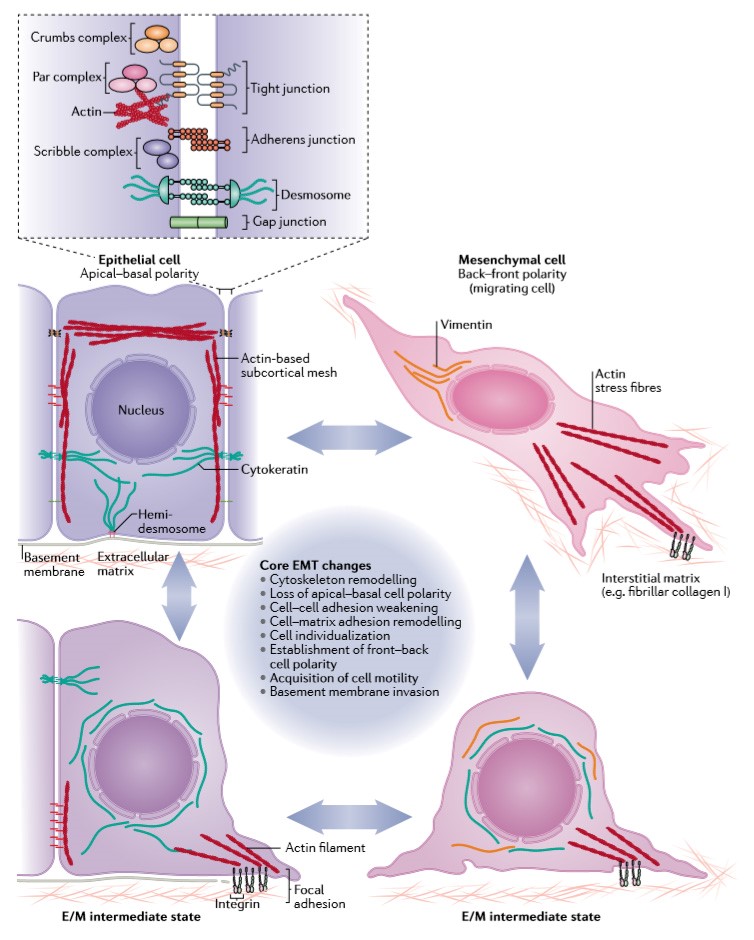- HOME
- News & Events
- Books / review / comments
- 【Books/review/comments】Guidelines and definitions for research on epithelial-mesenchymal transition
Books / review / comments
【Books/review/comments】Guidelines and definitions for research on epithelial-mesenchymal transition
April 17 2020
Lab: Guojun Sheng
Authors: Jing Yang, Parker Antin, Geert Berx, Cédric Blanpain, Thomas Brabletz, Marianne Bronner, Kyra Campbell, Amparo Cano, Jordi Casanova, Gerhard Christofori, Shoukat Dedhar, Rik Derynck, Heide L. Ford, Jonas Fuxe, Antonio García de Herreros, Gregory J. Goodall, Anna-Katerina Hadjantonakis, Ruby J. Y. Huang, Chaya Kalcheim, Raghu Kalluri, Yibin Kang, Yeesim Khew-Goodall, Herbert Levine, Jinsong Liu, Gregory D. Longmore, Sendurai A. Mani, Joan Massagué, Roberto Mayor, David McClay, Keith E. Mostov, Donald F. Newgreen, M. Angela Nieto, Alain Puisieux, Raymond Runyan, Pierre Savagner, Ben Stanger, Marc P. Stemmler, Yoshiko Takahashi, Masatoshi Takeichi, Eric Theveneau, Jean Paul Thiery, Erik W. Thompson, Robert A. Weinberg, Elizabeth D. Williams, Jianhua Xing, Binhua P. Zhou and Guojun Sheng
Title: Guidelines and definitions for research on epithelial-mesenchymal transition
Nature Reviews Molecular Cell Biology doi:10.1038/s41580-020-0237-9
Highlights:
- Epithelial-Mesenchymal Transition (EMT) is important in both development and cancer progression;
- EMT is driven is by a conserved set of inducing signals, transcriptional regulators and downstream effectors. EMT research is expanding rapidly with over 5,700 publications in 2019 alone;
- To propel EMT research to the next level, "The EMT International Association" (TEMTIA) has built a consensus among key scientists on definitions of EMT-related terms and on guidelines for future EMT research;
- This consensus will reduce misunderstanding and misinterpretation of research data generated in various experimental models and promote cross-disciplinary collaboration to identify and address key open questions in this research field.
Abstract:
Epithelial-mesenchymal transition (EMT) encompasses dynamic changes in cellular organization from epithelial to mesenchymal phenotypes, which leads to functional changes in cell migration and invasion. EMT occurs in a diverse range of physiological and pathological conditions and is driven by a conserved set of inducing signals, transcriptional regulators and downstream effectors. With over 5,700 publications indexed by Web of Science in 2019 alone, research on EMT is expanding rapidly. This growing interest warrants the need for a consensus among researchers when referring to and undertaking research on EMT. This Consensus Statement, mediated by 'the EMT International Association' (TEMTIA), is the outcome of a 2-year-long discussion among EMT researchers and aims to both clarify the nomenclature and provide definitions and guidelines for EMT research in future publications. We trust that these guidelines will help to reduce misunderstanding and misinterpretation of research data generated in various experimental models and to promote cross-disciplinary collaboration to identify and address key open questions in this research field. While recognizing the importance of maintaining diversity in experimental approaches and conceptual frameworks, we emphasize that lasting contributions of EMT research to increasing our understanding of developmental processes and combatting cancer and other diseases depend on the adoption of a unified terminology to describe EMT.

